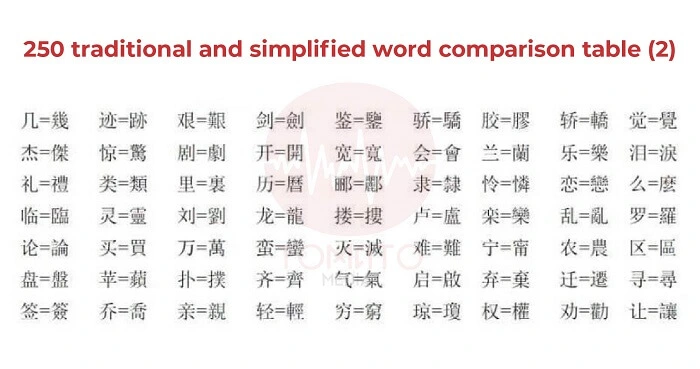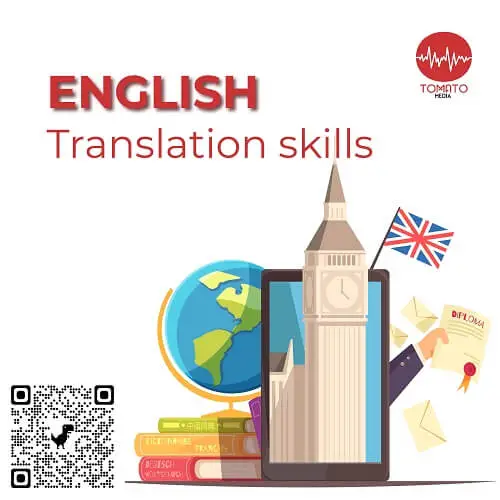German translation services in Hanoi and provinces | Professional – Prestige Tomato undertakes: 📗 Translation reflects the original with 100% accuracy 📗 Fast, punctual German translation services 📗 Absolute customer information confidentiality by NDA agreements 📗 Experienced German translators 📗 Reasonable public pricing ✆ 0938 596 333 ✉ GET A QUOTE You are looking for [...]
Distinguish traditional and simplified Chinese
More than 1.3 billion people use Chinese as their native language, making it one of the languages with the largest number of speakers in the world. The reason for this huge number is partly because China is among the most populous countries in the world and partly because the rapid development of the Chinese economy makes the language popular worldwide. In spite of its extreme popularity, unlike English, Chinese is a difficult language to learn because it has two forms: traditional and simplified Chinese. These two forms are relatively different, and in this article, we will explore everything about traditional and simplified Chinese.
NỘI DUNG (CONTENT)
What is traditional and simplified Chinese?
Before coming to the concept of traditional and simplified Chinese, it is necessary to clarify the following issues:
- Traditional Chinese and Simplified Chinese are two concepts used to distinguish how to write letters and are completely unrelated to Chinese pronunciation.
- Chinese pronunciation is divided into two categories: Standard Chinese (Beijing) and local Chinese (Mandarin, Cantonese, Shanghai, etc.).
Traditional Chinese is commonly referred to as traditional Chinese. Before 1950, traditional Chinese was simply called Chinese. However, when there was the introduction of a simpler type of Chinese, this type of traditional Chinese was called as it is today. Traditional Chinese can be used officially in areas such as Taiwan, Hong Kong, Macau, and other areas of China. The characters of traditional Chinese can be called “standard characters,” “mainstream characters,” “complex characters,” or “full Chinese characters.”
In 1950, the concept of Simplified Chinese was born, and it is a simpler version of traditional Chinese. Simplified letters are used mainly in China, Singapore, and Malaysia. Simplified Chinese is created by minimizing certain strokes in traditional Chinese or by simply replacing some strokes with another similar stroke. Some simplified words do not follow any rules, and some letters do not have similarities with traditional letters.
The History of Simplified and Traditional Chinese
Traditional Chinese, as the traditional language, first appeared alongside documents from the Han Dynasty and was relatively stable in the fifth century (both the South and North dynasties). Traditional Chinese is really a huge challenge for anyone who learns Chinese, even for Chinese people. The ancient Chinese used characters capable of depicting things and happenings to form writing. Over time, that character system evolved into something increasingly complex, sophisticated and called “traditional Chinese.”
Because it is difficult to absorb and difficult to remember, before 1950, the percentage of illiterate people in China was extremely high (up to 80%). This was an alarming situation for the Chinese government at the time. Aware of the country’s current literacy crisis, the Chinese party enhanced the practice of language simplification in 1950. Since then, simplified Chinese has been born and solved the illiteracy of this country.
Simplified Chinese has been a remarkable achievement since 1950. Firstly, it helped the Chinese people spectacularly get rid of illiteracy. Secondly, simplified Chinese contributed to the spread of Chinese culture to other countries around the world, paving the way for China’s extensive international integration process.
The introduction of simplified Chinese assists in simplifying Chinese learning. However, it does not mean that traditional Chinese will be lost. Currently, traditional Chinese is mainly used in Macau, Hong Kong, and Taiwan. Simplified Chinese is the most spoken language in mainland China, Singapore, and Malaysia. Furthermore, simplified Chinese is also the main language in all textbooks, publications, learning materials, references, etc.
Additionally, simplified Chinese is primarily used in Chinese teaching materials for foreigners. As a result, it can be seen that simplified Chinese is more popular than traditional Chinese.
The difference between traditional Chinese and simplified Chinese
1. The meaning of characters
Traditional Chinese and simplified Chinese have similarities in origin, but there is a big difference between them. The Chinese characters, i.e., traditional Chinese, were used by the ancient Chinese people to record the story of national history and the lives of the Chinese people from thousands of years ago. So each traditional word contains Chinese thoughts, ideas about life, stories related to family, neighborhood, courtesy, etc. When looking at any character, the reader can see its meaning through the analysis of its strokes.
Meanwhile, simplified Chinese does not have these profound meanings. Because simplified characters were created by simplifying the traditional ones, and the purpose was to increase the literacy rate of the Chinese people of the time,
A person who knows traditional Chinese can easily understand simplified Chinese, but a person who only knows simplified Chinese is unlikely to be able to read documents written in traditional Chinese. Here are some examples through which you can better understand the difference:
- 親 ( traditional) → omit the character “see” 見 → 亲 (simplified)
The traditional Chinese word “parents” 親 is used to refer to the family bond, which has the character “see” 見 removed on the right side, meaning “family that does not see” or having a family but ignoring it.
- 愛 (traditional) → omit the character “heart” 心 → 爱 (simplified)
The traditional Chinese word “love“ 愛 after being omitted the character “heart” 心 in the middle will become “heartless affection”, which means love without the heart.
2. Where to use
Nowadays, simplified Chinese has become one of the two types of letters officially used in China and is mainly popular in mainland China, Singapore, and Malaysia.
Traditional Chinese can be widely used in Taiwan, Hong Kong, and Macau.
3. Number of strokes
Simplified Chinese compared to traditional Chinese will probably have fewer strokes. This is considered a basic identity of traditional and Simplified Chinese.
| English meaning | Traditional Chinese | Simplified Chinese |
| Noodles | 麵 | 面 |
| Automatic | 自動 | 自动 |
| Excessive | 過分 | 过分 |
| Attitude | 態度 | 态度 |
| Turtle | 龜 | 龟 |
| Orchid | 蘭 | 兰 |
| Dragon | 龍 | 龙 |
Traditional Chinese and Simplified Chinese in document translation
Traditional Chinese can be a challenge not only for Chinese learners but also for scholars studying Chinese. For documents in traditional Chinese, translators must be highly qualified and have years of experience in working with traditional Chinese to be able to translate documents most accurately.
Traditional Chinese in document translation
- Traditional Chinese contains many characters that convey complex and deep meanings. One Chinese word is created with dozens of strokes and small characters, and this is also great difficulty in learning as well as translating documents in traditional Chinese.
- Every word in traditional Chinese can be a story. It has a profound meaning and is the essence of Chinese culture that the ancient people have drawn and brought into each character. Therefore, for documents written in traditional Chinese, the translator must have an in-depth understanding of traditional Chinese to be able to translate the deep meaning of the characters and to fully convey the views and thoughts of the writer.
- Documents written in traditional Chinese are often ancient texts handed down from hundreds or thousands of years ago or extensive research on traditional Chinese. Since it is widely used in Taiwan, Macau, and Hong Kong, you can also find documents, books, and books written in traditional Chinese in these regions.
Simplified Chinese in document translation
- Simplified Chinese is the simplification of traditional Chinese, so it has fewer strokes. This makes translating documents in simplified Chinese simpler than in traditional Chinese.
- In some documents written in simplified Chinese, one can still use traditional Chinese for vocabulary and expressions that simplified Chinese is unable to express. This is a difficulty in translating simplified Chinese documents. The reason is that people who know traditional Chinese can easily read and understand simplified Chinese, but people who know simplified Chinese may not understand traditional Chinese. Therefore, the translation of simplified Chinese documents also requires the translator to have the ability to search for and select documents.
- Simplified Chinese is widely used because of its simplicity. Simplified Chinese appears in most documents, from specialized documents to personal or business documents. Because of the extensive integration process with the world, almost all corporate documents and contracts are drafted in simplified Chinese.
Traditional and simplified Chinese comparison table
250 traditional and simplified word comparison table:
What should the translation of traditional and simplified Chinese documents be noted for?
Each language has its own characteristics and notes when translating. When translating traditional Chinese and simplified Chinese documents, there are notes to help make the translation more complete:
- Identify the exact type of translation document to choose the right writing style. The translation style is an important factor in creating a complete translation. For academic documents, contracts, business documents, etc., translators need to use short, clear, understandable, logical, and scientific styles; and avoid using words that express emotions in the translation.
- Chinese is a language with extremely rich and complex expressions. It is proven by the fact that many proverbs, idioms, and classic stories are preferred for use. Therefore, when translating, editors need to translate as close to the regional language as possible.
Need to translate traditional Chinese and Simplified Chinese? Call an expert.
Chinese is a difficult language to convert, so you need to choose a reputable translation unit to ensure your documents are translated correctly, and avoid wasting money, time, and trust. Most customers looking for traditional Chinese and simplified Chinese translation services have questions such as:
- Is the translation quality guaranteed?
- Is translation time fast or not?
- What are the Chinese translation warranties?
- Is the service attitude of the translation center satisfying?
- Transparent, clear, reasonable translation prices.
- etc.
Understanding that concern, Tomato Media is here to provide customers with traditional Chinese and simplified Chinese translation services of high quality, prestige, and professionalism. If you have any Chinese documents that need to be translated, whether traditional Chinese or simplified Chinese, contact Tomato Media in the following ways:
- Hanoi Head Office: Room 504, Kinh Do Building, 292 Tay Son, Trung Liet Ward, Dong Da District, Hanoi, Vietnam
- Branch in Bangkok: 362 Krungthep, Nonthaburi 2, Bangkok, Thailand
- Branch in Jakarta: 12th Floor, Wisma 46 Tower, Karet Tengsin, Jakarta, Indonesia.
- Hotline: 0938 596 333
- Zalo: 0938 596 333 (Tomato Media)
- Email: info@tomatomediavn.com
Frequently asked questions about traditional Chinese and simplified Chinese
Is HSK traditional Chinese or simplified Chinese?
HSK is administered only in Mandarin and simplified Chinese. However, if the test is on paper, the candidate can optionally choose to write in either simplified Chinese or traditional Chinese. The test can be on paper or on the Internet, depending on what the specific test center offers. If you are preparing for the HSK exam, simplified Chinese is the best option as it is used in the exam both on paper and on the Internet.
Is traditional Chinese or simplified Chinese used in Tawan?
Taiwan often uses traditional Chinese characters. In mainland China (中国 大陆), simplified Chinese is used, while traditional Chinese can be used in Hong Kong (香港), Macau (澳门), and Taiwan (台湾).
How many characters do you need to start with Chinese?
3,000 traditional Chinese characters. Although it is very complicated to estimate the total number of Chinese characters, it is worth mentioning that native Chinese are proficient in more than 5,000 characters. In particular, they use about 3,000 characters in everyday life. If you want to start with Chinese properly, you’ll need to learn those 3,000 characters.
Hopefully, this article has helped some readers understand what traditional Chinese and simplified Chinese are, the difference between the two, as well as the history of traditional Chinese and simplified Chinese. Each language has its own distinct characteristics, which are irreplaceable. Therefore, understanding the characteristics and generalizations of that language will help us to somewhat grasp its meaning in everyday life. If you have any questions about traditional Chinese or simplified Chinese, as well as a need to translate Chinese documents, contact Tomato Media for feedback and the most detailed advice.






















